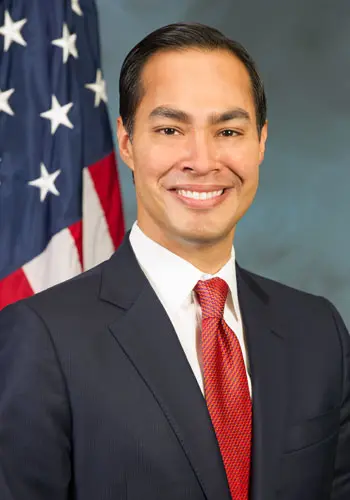At Google’s Googleplex headquarters in Mountain View, Calif., Alphabet executive chairman Eric Schmidt held a “fireside chat” on Thursday morning with Julián Castro, the secretary of the U.S. Department of Housing and Urban Development. Much of it addressed the sort of topics you might assume would occupy most of the HUD secretary’s attention, such as homelessness and high rents. But–this being Google–the Internet was also a major subject.

According to Castro, over half of low-income Americans and the vast majority of those in public housing don’t have Internet access at home. ConnectHome, an initiative announced last July by President Obama, aims to bring broadband connectivity to such people. Starting off in 27 cities (and the tribal nation of Choctaw in Oklahoma), it served 275,000 households at launch last July. Castro said that his goal is to have a plan to offer broadband to every public-housing home by the time he ends his HUD term.
The biggest goal of ConnectHome, he told Schmidt, is to help young people do better in grade school, graduate from high school, and go on to graduate from college. “And hopefully [go] into companies like like Google, and others, and reach their dreams.”
“The United States finds itself in this unprecedented competition for talent and brainpower with nations around the world that are producing tons of young people who are intelligent and talented and tech-savvy,” he said. “We need to do our part to make sure we don’t let any of that talent go to waste.”
As part of its Google Fiber initiative, Alphabet is providing free high-speed Internet access to some public-housing facilities in Atlanta, Durham, Kansas City, and Nashville. Schmidt pointed out that public housing tends to be dense, which makes it simpler to roll out broadband to more people. “It’s a no-brainier as a public act for corporations and [HUD] to make this happen, and the benefits are very quick,” Schmidt said. “The simple rule about fiber is once you have it in place, it’s just a godsend.”
A Challenge Both Technical And Legislative
Castro drew a connection between public-broadband projects such as ConnectHome and disruptions relating to everything from transportation (Uber and Lyft vs. taxi companies, Tesla vs. car dealers) and beer (craft brewers vs. industry giants). “You can see these fascinating issues that present themselves with the new economy and old economy and how that interacts with public-lawmaking,” he said.
He added that his hometown of San Antonio, where he served as mayor for three terms, built a fiber network in the 1990s, but it continues to be hamstrung by legislation championed by an unnamed company. “You have this community that’s sitting on this fiber network–it’s not the only one–and is not able to use it…we’re not maximizing our potential sometimes. I believe we need all hands on deck.”
Besides Alphabet, numerous tech companies and organizations are part of the all-hands ConnectHome initiative. For instance, Sprint, Cox, and CenturyLink are providing free or low-cost connectivity; companies such as Best Buy, Khan Academy, and GitHub are involved in digital literacy and training.
Even without these efforts, many young people from low-income homes are extremely comfortable with technology, Castro says: They’re on Twitter, Facebook, and Instagram. But the tech industry could further boost ConnectHome by helping it bring computing devices better suited to education into more households.
“In poor communities, you have a lot of take-ups of smartphones and gadgetry,” Castro told me after the fireside chat. “That’s not the same as a bigger tablet or laptop. I mean, who does their homework on a smartphone?”
Recognize your brand’s excellence by applying to this year’s Brands That Matter Awards before the early-rate deadline, May 3.
